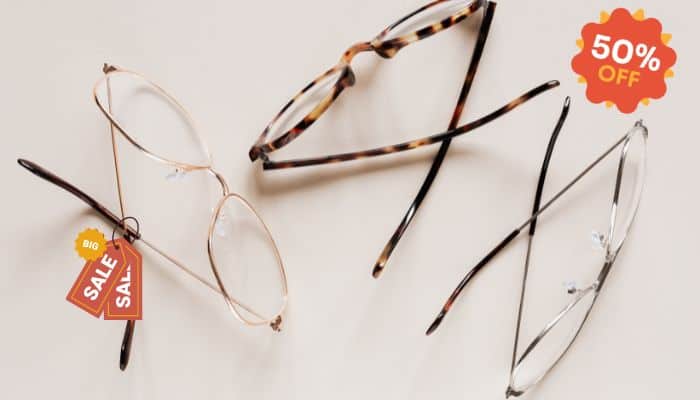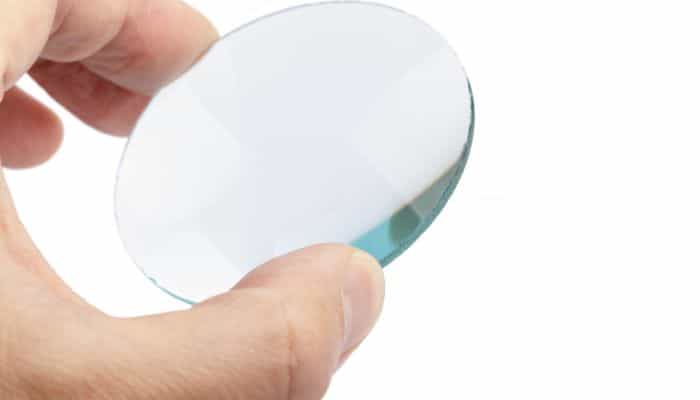Transition lenses? Yes, please! Paying a small fortune for them? No, thanks.
That was the exact dilemma I faced during my last visit to the eye doc. The convenience of not having to switch between my regular glasses and sunglasses was something I really wanted. But as I contemplated my options, the cost hit me hard.
The good news is, there are plenty of ways to save on photochromic – or light-adjusting – lenses, especially when you’re already paying an arm and a leg for prescription glasses.
(This page contains affiliate links. OGR may receive compensation if you click a link and make a purchase.)
How Much Do Transition Prescription Glasses Cost?
Transitions™ (the brand) lenses don’t come cheap. How much can you expect to pay?
Average Cost of Transitions™ Lenses

Depending on your prescription, you might pay anywhere from $100 to $500 for the lenses alone, which doesn’t include the cost of your frame.
Prices also differ depending on the retailer. Online stores may offer Transitions™ lenses at a more competitive price compared to an optical store or eye doctor’s office.
Plus, there are varying Transitions™ lens options too, with the most common being Transitions™ Signature.
Here’s a sampling of prices we found as of July 2023:
| Optical Retailer | Transitions Signature | Transitions XTRActive | Transitions Drivewear | Transitions XTRActive Polarized |
|---|---|---|---|---|
| Zenni Optical | $69 | $121.95+ | N/A | N/A |
| GlassesUSA | $99+ | $149+ | N/A | $179+ |
| FramesDirect | $269.96 | $269.96 | N/A | N/A |
| Walmart Vision Center | $85+ | N/A | N/A | N/A |
| LensCrafters | $183.33+ | $200+ | N/A | N/A |
| EyeBuyDirect | $99 | $139 | $149 | N/A |
| Target Optical | $195+ | $195+ | N/A | N/A |
| Costco Optical | $40+ | N/A | N/A | N/A |
Lenscrafters Source
Comparing Costs: Transitions™ Lenses vs. Regular Prescription Lenses and Sunglasses
Let’s not dance around it: Transitions™ lenses cost more than regular prescription lenses. After all, they’re like two glasses in one, right?
But when you consider the convenience and the savings from not having to buy a separate pair of prescription sunglasses, it might make financial sense.
If you were to buy a separate pair of prescription sunglasses, depending on the brand and the specifics, you could be looking at an additional $200 to $500.
So, if you’re someone who values convenience, functionality, and maybe a little bit of that cool factor, photochromic lenses might just be worth the investment.
Are Transition Lenses Worth It?
How to Save Money on Transition Lenses
Are these prices raising your eyebrows? (They’re certainly raising mine!) Here are some strategies to make photochromic lenses a bit more affordable.
Look for Discounts and Coupons from Online Retailers

One way to score a deal on Transitions™ lenses is with online eyewear retailers. As the chart above shows, it pays to shop around as the cost can vary significantly from one optical to the next.
You can even manage discounts as high as 60% off if you catch a sale going on. FramesDirect and GlassesUSA are two retailers that often run lens promos and discounts for significant savings.
Pros and Cons of Buying Online vs. In-store
Pros:
- You can save time and money by comparing prices and styles online. It’s like having the power of a personal eyewear shopper at your fingertips.
- Access to a wide array of options is another perk of the online experience. You can get access to more options and discounts than in-store.
Cons:
- Buying online means you can’t physically try on the glasses before you purchase. It’s a bit of a leap of faith (which can be tempered by varying return policies).
- You may need to wait longer for delivery and deal with potential issues with returns or exchanges.
Best Prescription Sunglasses For Driving
Use Vision Insurance or Flexible Spending Accounts (FSA/HSAs) to Pay for Transitions Lenses

Definitely make use of your vision insurance or FSA/HSA benefits if you’ve got them! They may cover part or all of the cost of transition lenses, depending on your plan and provider.
Companies like EyeMed and VSP offer Transitions lenses as an add-on option for a copay of $75 at in-network providers.
They also provide discounts on frames and other lens enhancements at participating providers.
As long as you’re purchasing prescription glasses, Transitions glasses are eligible for reimbursement from your FSA or HSA. That’s what we call a win-win!
Pros and Cons of Using Insurance or FSA
Pros:
- You can reduce your out-of-pocket expenses and get more bang for your buck. Think of it as a coupon that renews every year.
- Convenience and flexibility of using your benefits online or in-store.
Cons:
- You may have to pay a copay or deductible for transition lenses.
- There may be certain rules and restrictions on how and when to use your benefits. Make sure to do your homework and understand your policy before jumping in.
Consider Off-Brand Photochromic Lenses

Looking for the benefits of Transitions™ lenses without the premium price tag? They do exist, in the form of off-brand photochromic lenses.
What are Off-Brand Photochromic Lenses?
Off-brand photochromic lenses, or generic equivalents, are lenses that darken in response to sunlight, similar to Transitions™ lenses. However, they’re not associated with the Transitions™ brand.
Rather, they’re your optical shop’s in-house formulation. Think of them like the store-brand version of your favorite breakfast cereal.
In terms of quality, performance, and price, there’s quite a range.
Some house-brand lenses perform fairly well when compared with Transitions™ lenses, but most don’t darken or clear as quickly.
Generally, off-brand photochromic lenses are best if you don’t need a very dark tint when outside and don’t mind the slower transition time.
Generic Alternatives
Just like Transitions™ lenses, you can find these cost-effective substitutes at a variety of sources, from online retailers to optical stores to eye doctors.
Many lens manufacturers offer their own version of photochromic lenses.
Here’s a sampling of the cost at a few online opticals:
| Optical Retailer | Cost of House Photochromic Lenses |
|---|---|
| Zenni Optical | $29+ |
| EyeBuyDirect | $35.95 |
| GlassesUSA | $59+ |
| Liingo Eyewear | $79 |
| Warby Parker | $100 |
Pros and Cons of Choosing Off-Brand Photochromic Lenses
Pros:
- Your wallet will definitely breathe a sigh of relief – you’ll usually save a pretty penny by choosing in-house photochromic lenses.
- With so many different budget-friendly options available, you might find a lens option that caters to your specific needs and preferences better than Transitions™ lenses.
Cons:
- Generic photochromic lenses tend to darken slower than Transitions™ and don’t get as dark at full tint.
- Any warranty and customer service might also differ from what you would get with Transitions™ lenses. Always check the warranty and return policy before purchasing.
How to Choose the Best Transition Prescription Glasses for You
When it comes to selecting the best transition prescription glasses, there’s more to it than just selecting a frame that complements your face shape (although that’s pretty important, too).
One aspect that’s often overlooked is choosing the right lens color to suit your vision.
Choose the Right Lens Color

Different lens colors (or tints) can significantly impact your vision quality and comfort in varying light conditions and environments.
So, it’s essential to understand what each color offers to pick what’s best for your lifestyle and vision needs.
The three most common lens colors for transition prescription glasses are gray, brown, and green. Each offers its own benefits:
Gray lenses provide the most neutral color perception. They dim the light without altering the color of your surroundings, making them a great all-rounder.
Brown lenses can enhance contrast, making them a top pick for those who spend a lot of time driving or participating in activities that require depth perception like golf.
Green lenses can increase contrast in low light conditions and reduce glare, making them an excellent choice for sports such as golf, tennis, and baseball. Like gray lenses, green is a neutral that doesn’t distort vision.
Weighing the Pros and Cons
Gray lenses:
- Pros: These lenses offer accurate color perception, making them great for everyday wear.
- Cons: They might not provide enough contrast for sports or other activities requiring depth perception.
Brown lenses:
- Pros: Their enhanced contrast can be a game-changer for activities like driving or golf.
- Cons: They can distort color perception a bit, making certain hues look warmer.
Green lenses:
- Pros: They’re great for outdoor sports, providing contrast and reducing glare in varying light conditions.
- Cons: The color may not be to everyone’s liking from an aesthetic standpoint.
Choose the Right Lens Material and Treatments
While frame style and lens color are crucial, the lens material and coating(s) are equally important for your prescription strength, visual acuity, and overall eye health.
Lens Material Options

Plastic (CR-39)
Plastic lenses, also known as CR-39 lenses, are the basic lens material and work best for light prescriptions up to +/-1.75.
- Pros: They’re inexpensive, lightweight, and offer good optical quality.
- Cons: They’re not the most durable or scratch-resistant, and can be too thick for stronger prescriptions.
Polycarbonate
Polycarbonate is thinner (30% thinner than plastic) and lighter, making it suitable for prescriptions up to +/-4.00. It also inherently blocks UV rays, meaning you won’t need an additional UV coating.
- Pros: The durability and impact-resistance make this material perfect for kids’ glasses or active lifestyles. The built-in UV protection is another significant advantage.
- Cons: It can introduce some color distortion and doesn’t have as high an optical quality as plastic.
High-Index Lenses
High-index lenses are even thinner (up to 50% thinner than CR39) and lighter, ideal for higher prescriptions above +/-4.00.
- Pros: These lenses help reduce the “bug-eye” or “coke-bottle” effect caused by thicker lenses.
- Cons: They’re more expensive than plastic or polycarbonate and can produce more reflections and glare without additional treatment.
Optional Lens Coatings

Anti-Reflective Coating (AR)
As the name implies, anti-reflective coating reduces reflections on the lens surface, improving clarity and contrast in varying light conditions.
- Pros: It helps decrease glare from headlights, streetlights, or screen use, enhancing night driving or reading experiences. It also gives your lenses a more transparent look.
- Cons: You may need to clean your lenses more frequently.
Scratch-Resistant Coating
Scratch-resistant coating offers protection against everyday wear and tear that can cause scratches.
- Pros: It extends the lifespan of the lenses and maintains their optical quality.
- Cons: It doesn’t make the lenses entirely scratch-proof, so proper care and cleaning are still essential.
Ultraviolet Protection (UV)
UV-coating blocks harmful UV rays from the sun, which can lead to eye damage and diseases such as cataracts or macular degeneration.
- Pros: UV protection is a significant bonus for eye health.
- Cons: Some materials, like plastic, might need an additional UV coating.
Bottom Line
It’s possible to get prescription transition lenses without breaking the bank. While generic photochromic lenses will save you some money, you’ll usually have to settle for slower transitions and not as dark a lens in the sun.
Our recommendation? If you’re going to invest in photochromic lenses, get Transitions™ lenses, but shop around for the best price. Don’t limit yourself to brick-and-mortar shops, and do take advantage of bundle discounts or insurance coverage you have.
You’ll get the best value this way, even though you may need to spend a bit more upfront.